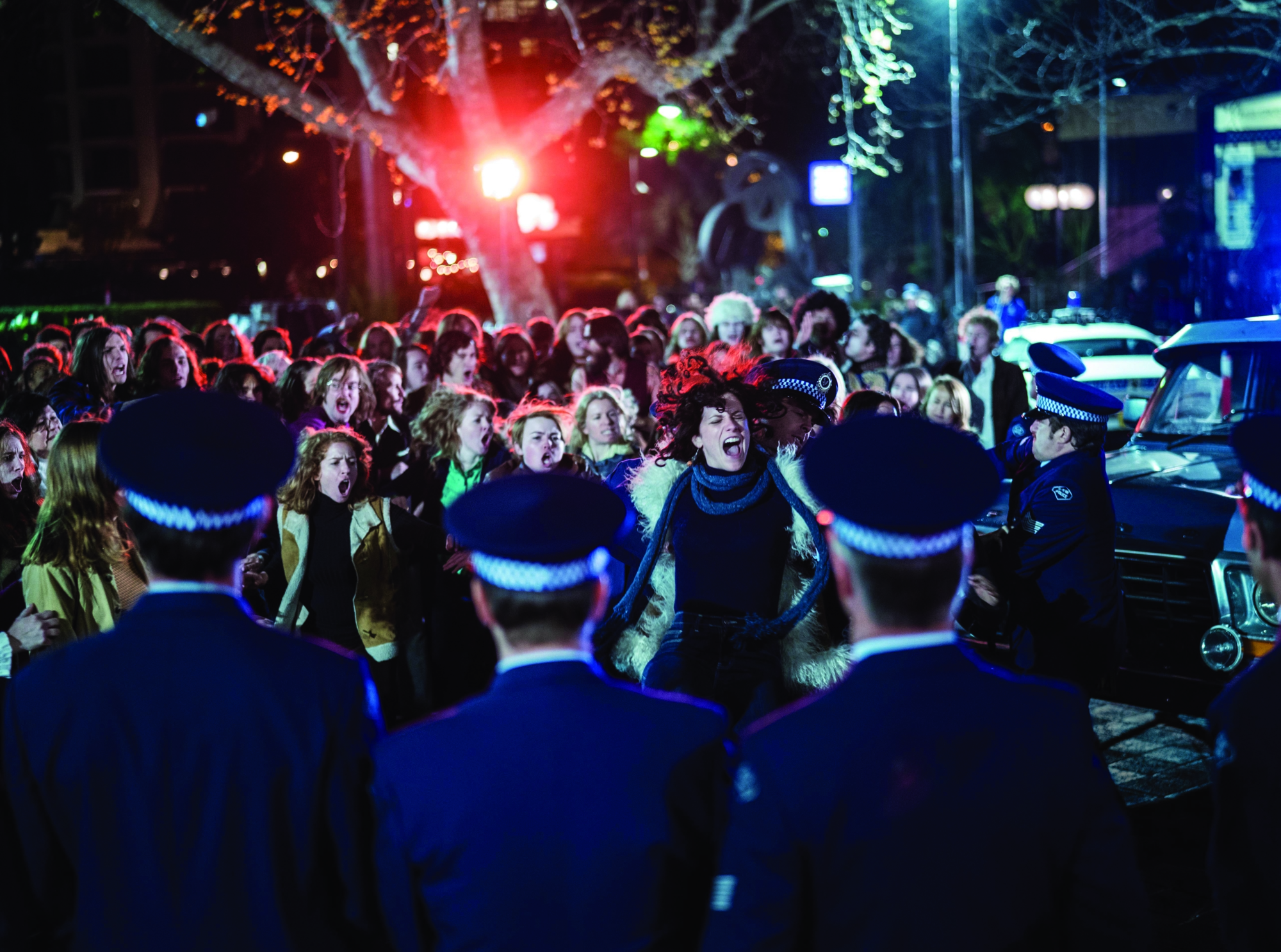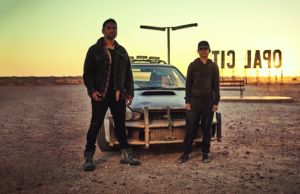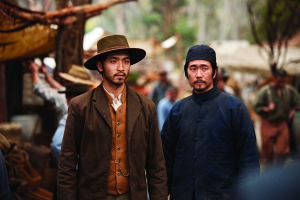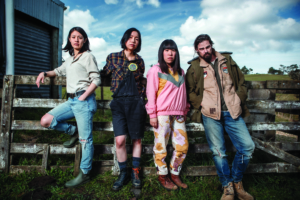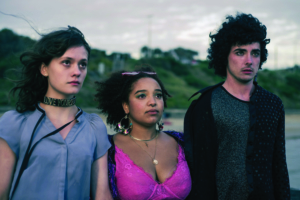Last year, the BBC launched ‘Gay Britannia’, a series of programs marking the fiftieth anniversary of the UK’s Sexual Offences Act 1967, which saw the partial decriminalisation of homosexuality. The series brought audiences a suite of LGBTQIA+ content, including the flagship drama miniseries Man in an Orange Shirt; based-on-true-events telemovie Against the Law (Fergus O’Brien, 2017), about journalist Peter Wildeblood; archival patchwork Queerama; documentaries including Olly Alexander: Growing Up Gay (Vicki Cooper, 2017) and Gluck: Who Did She Think He Was? (Clare Beavan, 2017); and a collection of podcasts as well as radio and TV specials.
Compared to the commemorated moment in UK history, it would take eight additional years for the first Australian state to decriminalise homosexuality: South Australia, in 1975. The rest of the states and territories would follow suit over the next twenty-two years.[1]Ben Winsor, ‘A Definitive Timeline of LGBT+ Rights in Australia’, SBS Sexuality, 15 November 2017, <https://www.sbs.com.au/topics/sexuality/agenda/article/2016/08/12/definitive-timeline-lgbt-rights-australia>, accessed 27 May 2018. As a result of this scattered local history, the closest that LGBTQIA+ Australians have as a defining historical moment is the event we now know as the Sydney Gay and Lesbian Mardi Gras. The events of 24 June 1978 began as a night of celebration designed to pay tribute to the Stonewall riots in the United States, but soon turned violent at the hands of a homophobic police force unprepared for a large-scale movement of various individuals rising up out of their oppression. What began as a party-turned-protest held on Oxford Street, home of Sydney’s most prominent gay venues, has since become an internationally recognised pride event that attracts the disparate likes of Cher and Malcolm Turnbull.
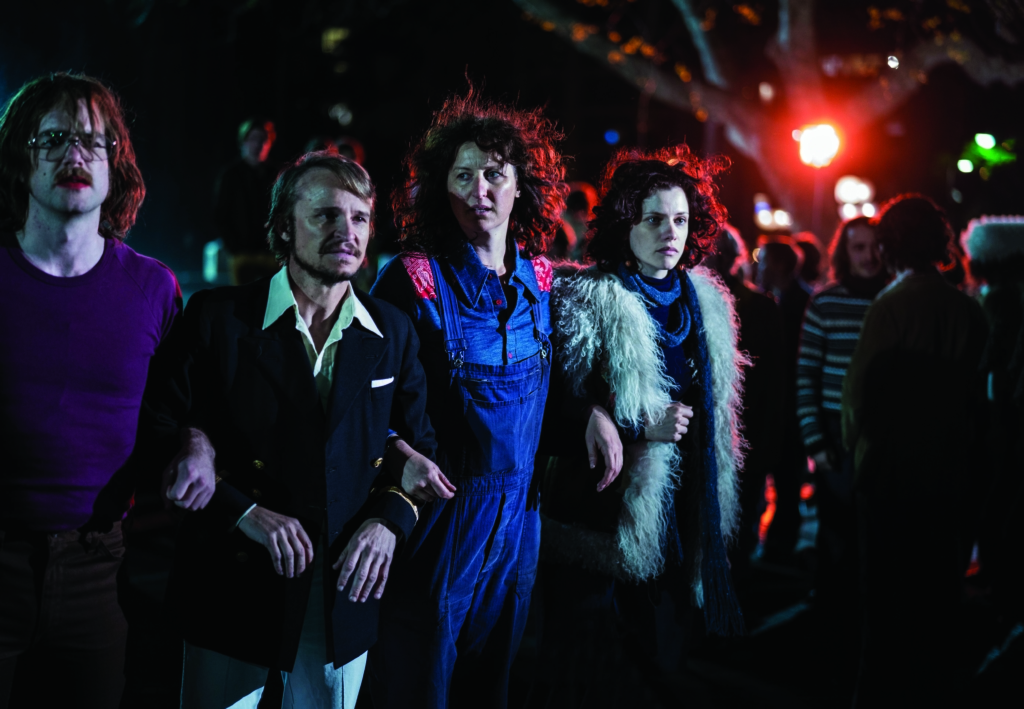
While not quite on the scale or specificity of ‘Gay Britannia’, a number of queer-themed works did make their way onto our screens in the lead-up to as well as upon the fortieth anniversary of Mardi Gras in Australia. SBS produced three companion works about the gay-hate crimes that took place in the 1970s to the 1990s around Bondi and Tamarama: the four-part 2016 miniseries Deep Water, the documentary Deep Water: The Real Story (Amanda Blue, 2016) and a journalistic investigation called The Gay-Hate Decades: 30 Unsolved Deaths, published on the network’s website. Screen Australia and ABC Arts premiered Love Bites, a series of ten short films by LGBTQIA+ filmmakers, while NITV aired Black Divaz (Adrian Russell Wills, 2018). And the National Film & Sound Archive of Australia (NFSA) launched its digital restoration of the iconic documentary Witches, Faggots, Dykes and Poofters (Digby Duncan & One in Seven Collective, 1980) at Queer Screen’s Mardi Gras Film Festival.
That 1980 documentary, which is little seen and has long been out of circulation,[2]To view the film in 2016, I had to request a VHS copy from the NFSA in Canberra, to be viewed at the now-defunct mediatheque at the Australian Centre for the Moving Image in Melbourne. no doubt proved important to the making of Riot (Jeffrey Walker, 2018). Perhaps the largest-profile production to have been released to honour forty years of Sydney’s Mardi Gras, this ABC telemovie charts the time leading up to the first Mardi Gras, trawling through the shambolic innercity sharehouses of Sydney where activist meetings and protest preparations were held. Damon Herriman stars as Lance Gowland, a public servant and son to communist parents who ditches beers with the lads for cruising in the park. He revels in recounting how he had borne witness to Martin Luther King Jr’s ‘I Have a Dream’ speech to nervous prisoners waiting out their time. When he meets a handsome doctor, Jim Walker (Xavier Samuel), his gay-rights activism goes into over-drive, culminating in the violent confrontation that immortalised Mardi Gras in its infancy.
With contemporary eyes, we can see that the 1970s’ conversations about sexual liberation, divides between the factions of the LGBTQIA+ community, and antagonism between these communities as well as with police and politicians are still with us today.
Much like in When We Rise – another recent television title about gay-rights activism, this time based on the memoirs of San Franciscan activist Cleve Jones – there aren’t any particularly new narrative beats in Riot. Indeed, viewers will likely recognise many of the story’s mechanics through their familiarity with other stories of gay-rights activism, like Milk (Gus Van Sant, 2008), How to Survive a Plague (David France, 2012), The Normal Heart (Ryan Murphy, 2014) and BPM (Beats Per Minute) (Robin Campillo, 2017). Still, Riot is a handsomely made film – and one whose Australian focus gives it something entirely unique. Even if the event’s import has become part of this country’s culture, it’s amazing to realise that its history has never been chronicled on film in this way before. There is something altogether different – and more rewarding – about watching a story that takes place on our own doorstep: these people once committed themselves to protest and celebration alike in places as familiar as Sydney’s Hyde Park and Oxford Street.
In its best moments, Riot reminds us of how these historical moments are connected to our society today, which is still very much grappling with issues relating to LGBTQIA+ rights and justice. In the shadow of marriage equality and the ‘Yes’ campaign, seeing and hearing characters discuss topics that were once considered radical is heartening. With contemporary eyes, we can see that the 1970s’ conversations about sexual liberation, divides between the factions of the LGBTQIA+ community, and antagonism between these communities as well as with police and politicians are still with us today. And, as a new queer generation emerges, emboldened by changes in societal norms and access to information – not to mention the introduction of PrEP,[3]Pre-Exposure Prophylaxis (PrEP) is a once-a-day pill aimed at stopping the spread of HIV. which has spurred something of a second sexual awakening among gay men[4]Jacob Anderson-Minshall, ‘The New Gay Sexual Revolution’, The Advocate, 15 May 2017, <https://www.advocate.com/current-issue/2017/5/15/new-gay-sexual-revolution>, accessed 27 May 2018. and all of the potential for sex shaming that comes with it[5]See, for example, Josh Galassi, ‘PrEP Diaries Author Talks Controversy, Slut Shaming, and How It’s More than Just a “Party Drug”’, Queerty, 16 April 2017, <https://www.queerty.com/prep-diaries-author-talks-controversy-slut-shaming-just-party-drug-20170416>, accessed 27 May 2018. – these themes become more pertinent than ever, even if the language used by Riot’s subjects is less ‘woke’ than what might get bandied around today.
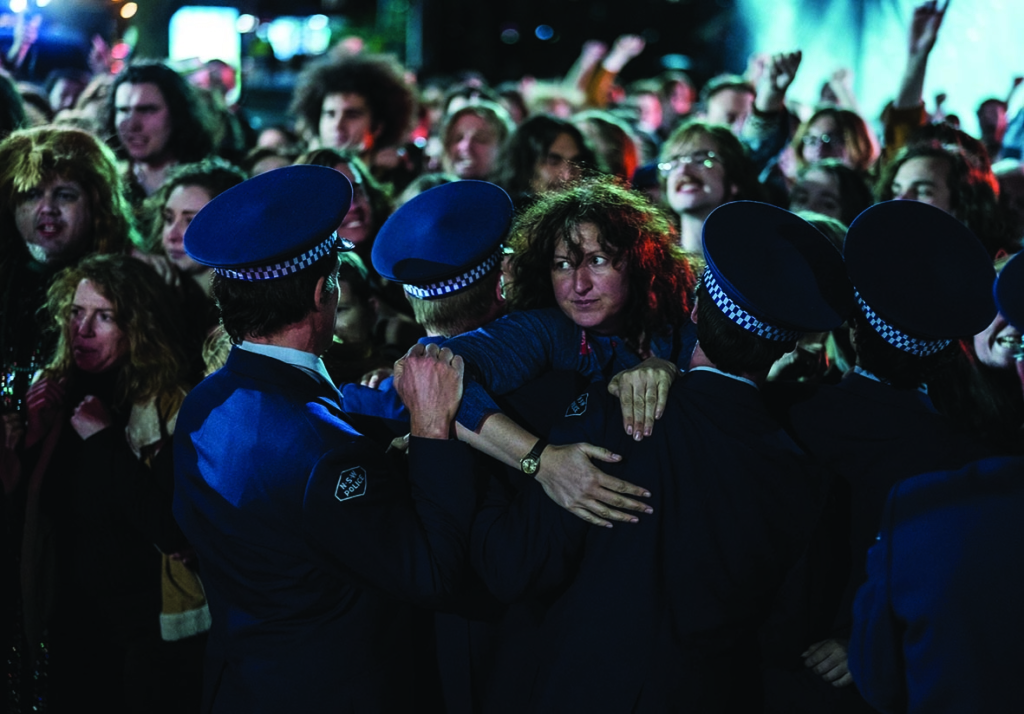
The other thing that Riot does really well is highlight how many different stories can be told from this era. We watch the 1972 decision by the ABC program Chequerboard to feature a story about Peter Bonsall-Boone (Eden Falk) and Peter de Waal (Luke Mullins), who would share the first same-sex kiss on Australian television. As shown in Riot, Bonsall-Boone was fired from his job at an Anglican church that very night. A tear-jerker for the ages is also found in the story of Marg McMann (Kate Box, arguably Riot’s MVP) and her groundbreaking fight for custody of her children as an out lesbian living with her partner, Robyn Plaister (Jessica De Gouw). In turn, Robyn would be the subject of one of the most famous photographs of the 1978 Mardi Gras: she is dragged by one arm by police towards a paddy wagon, her other arm gripped tightly by fellow Mardi Gras attendees.
There are so many LGBTQIA+ narratives to be mined from among Riot’s various characters that it makes one really wish Australia had the sort of screen industry that could support the telling of more of them (even if through underground film coops like Witches, Faggots, Dykes and Poofters’ One in Seven Collective). What would Riot’s story have looked like, for instance, from the point of view of Gabrielle Antolovich (Hanna Mangan Lawrence), a young activist who was only nineteen when she publicly came out on Chequerboard? My interest was particularly piqued by what is recognised as the world’s first ‘pink ban’ – put in place by the Builders Labourers Federation trade union over Macquarie University’s Robert Menzies College for their treatment of gay student Jeremy Fisher (Will McDonald) – which is raised in Riot and then forgotten about several minutes later. And, while the telemovie does show the blossoming of Sydney’s drag scene, it only does so in passing. What a treat it would have been to learn more about this world that, arguably, remained largely unknown to the general public until the release of The Adventures of Priscilla, Queen of the Desert (Stephan Elliott, 1994) and Ladies Please! (Andrew Saw, 1995).
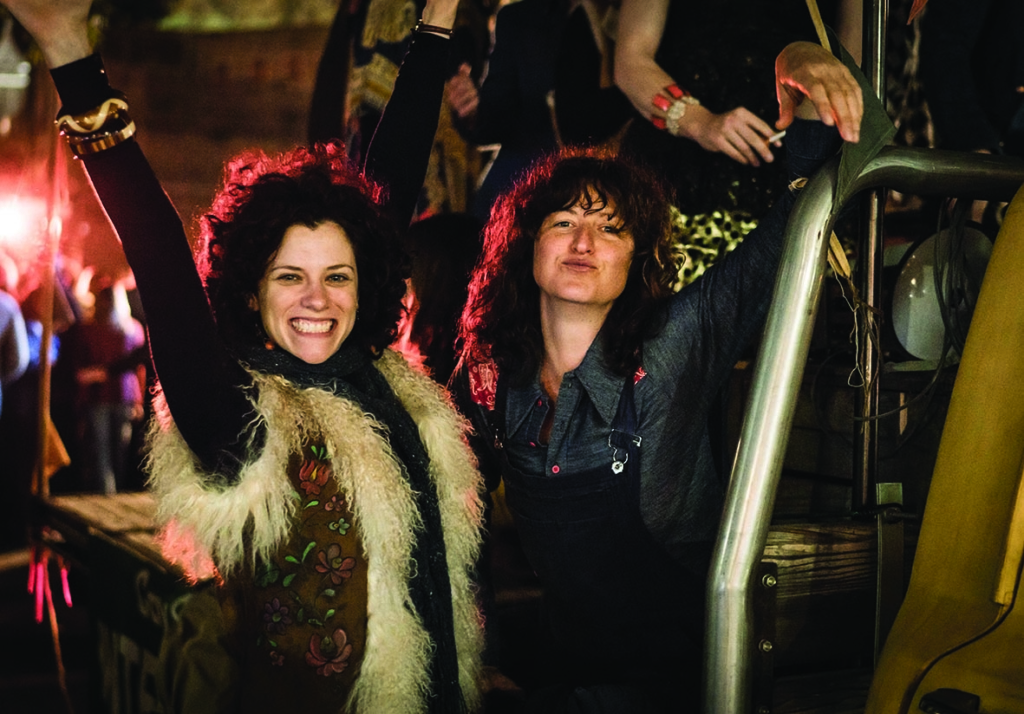
Certainly, Walker’s 105-minute production – which spans 1972 to 1978 – is entertaining and briskly paced. Yet, while it is a story well told, being condensed into one night’s worth of television hinders it from offering a deeper dive into the underground LGBTQIA+ cultures and communities of Sydney (and perhaps beyond). As it stands, many characters appear as though they have been given short shrift by Greg Waters’ screenplay. Riot had the potential to become something bigger, something more canonical – undone, perhaps, by the obstacles of making queer art for a mainstream audience.
It’s sadly understandable why Riot’s makers kept it so streamlined. Period pieces like this are expensive, and, while media discourse suggests that viewers are clamouring for diversity on screen, it rarely seems to be in the form of historical narratives like Riot, Deep Water or Holding the Man (Neil Armfield, 2015).
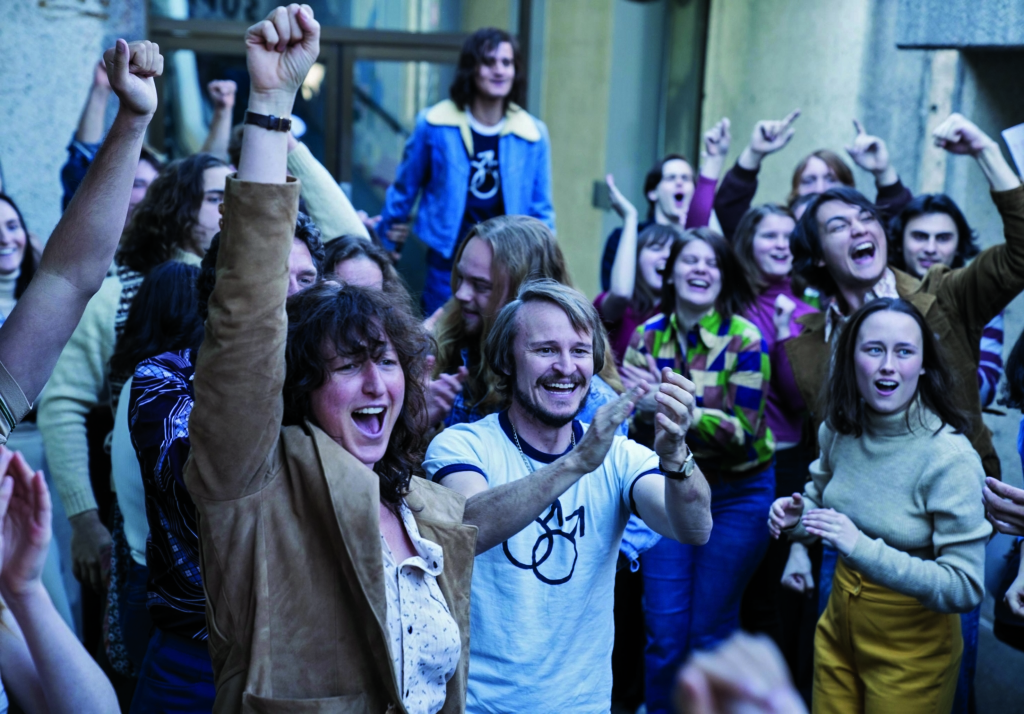
This limitation isn’t helped by the fact that the telemovie was aired during the actual two-and-a-half-week Mardi Gras celebrations, when there was substantial TV coverage of proceedings. Competition for audience attention aside, this juxtaposition between today’s incarnation of Mardi Gras and 1978’s does make Riot – as historical mediator – so pivotal to our understanding of the fortieth-anniversary celebrations. It should be noted that Mardi Gras itself did not have any involvement in the production of Riot, and there is no mention of what the event has become in recent years. Nor is there any nod to sentiments like those expressed by Plaister, who has said that today’s Mardi Gras
is not how I would have imagined it would become in terms of the politics. As a woman, I found the Mardi Gras became all about men and their sexual freedom rather than fighting the wider concerns we had originally of homophobia, sexism and racism.[6] Robyn Plaister, ‘Mardi Gras Has Given Hope to Many Young People’, in ‘Mardi Gras Marchers from 1978 Reflect on Decades of Protest and Celebration’, The Guardian, 25 February 2018, <https://www.theguardian.com/tv-and-radio/2018/feb/25/mardi-gras-marchers-from-1978-reflect-on-decades-of-protest-and-celebration>, accessed 27 May 2018.
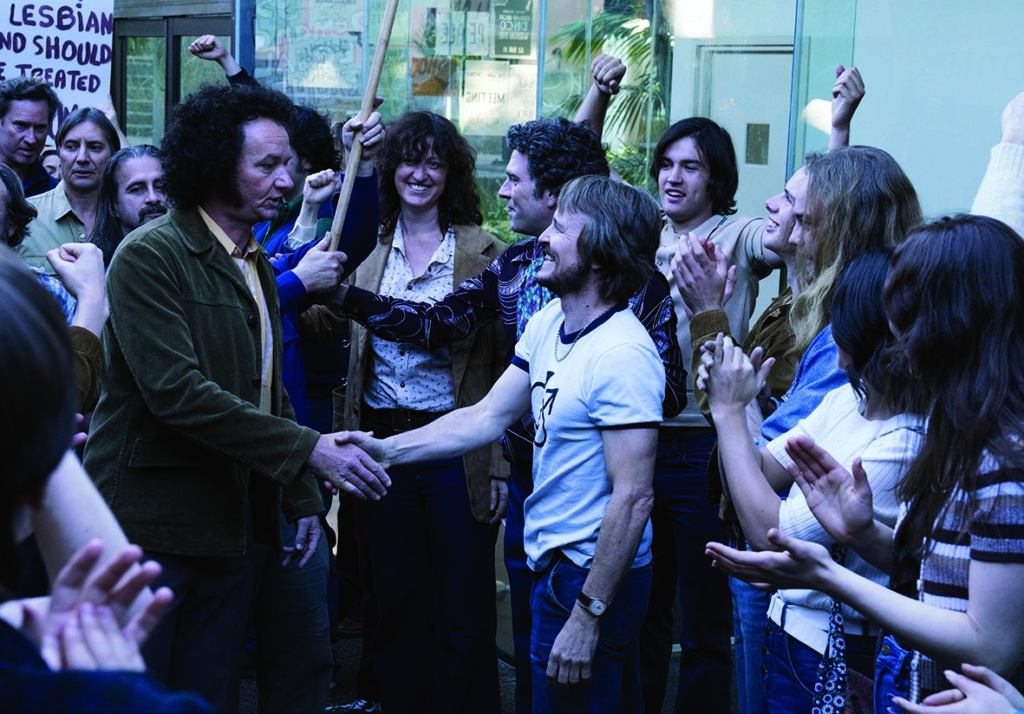
Like watching the parade on television as opposed to being there in the (barely clothed) flesh, Riot can’t quite capture the vibrancy and political gravity of the real events that inspired its creation. It certainly has a polished look – Martin McGrath’s cinematography strikes the right visual tone, and Pete Baxter’s production design makes wise use of pre-existing, period-appropriate innercity housing and bars – and what audiences see on screen is often wonderful and even thrilling. But it doesn’t quite take advantage of the television medium’s ability to allow stories to unfold over multiple instalments. Riot is a great night in front of the telly, but could have been an even greater one had it been allowed to expand and offer viewers more of the fascinating, dizzying world it depicts – just like Mardi Gras itself has done forty years after its maiden voyage.
https://clickv.ie/w/metro/riot
Endnotes
| 1 | Ben Winsor, ‘A Definitive Timeline of LGBT+ Rights in Australia’, SBS Sexuality, 15 November 2017, <https://www.sbs.com.au/topics/sexuality/agenda/article/2016/08/12/definitive-timeline-lgbt-rights-australia>, accessed 27 May 2018. |
|---|---|
| 2 | To view the film in 2016, I had to request a VHS copy from the NFSA in Canberra, to be viewed at the now-defunct mediatheque at the Australian Centre for the Moving Image in Melbourne. |
| 3 | Pre-Exposure Prophylaxis (PrEP) is a once-a-day pill aimed at stopping the spread of HIV. |
| 4 | Jacob Anderson-Minshall, ‘The New Gay Sexual Revolution’, The Advocate, 15 May 2017, <https://www.advocate.com/current-issue/2017/5/15/new-gay-sexual-revolution>, accessed 27 May 2018. |
| 5 | See, for example, Josh Galassi, ‘PrEP Diaries Author Talks Controversy, Slut Shaming, and How It’s More than Just a “Party Drug”’, Queerty, 16 April 2017, <https://www.queerty.com/prep-diaries-author-talks-controversy-slut-shaming-just-party-drug-20170416>, accessed 27 May 2018. |
| 6 | Robyn Plaister, ‘Mardi Gras Has Given Hope to Many Young People’, in ‘Mardi Gras Marchers from 1978 Reflect on Decades of Protest and Celebration’, The Guardian, 25 February 2018, <https://www.theguardian.com/tv-and-radio/2018/feb/25/mardi-gras-marchers-from-1978-reflect-on-decades-of-protest-and-celebration>, accessed 27 May 2018. |
